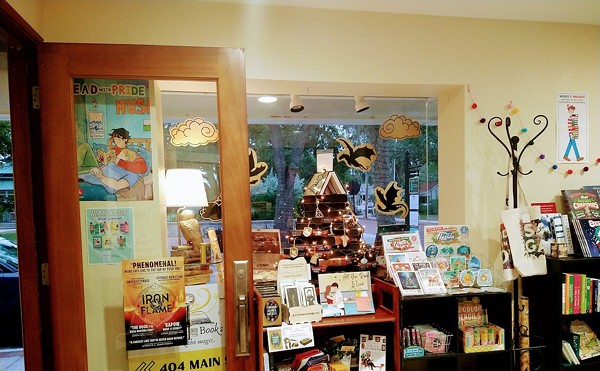
Watching a bright and attractive show like How the Garcia Girls Lost Their Accents, you almost don’t notice that it lacks the larger significance that it obviously aspires to. Composed of episodic scenes in reverse chronology, the play introduces us to the four Garcia sisters — Yolanda, Carla, Sandra, and Sofia — and quickly convinces us of their vibrant, even passionate emotional lives.
But then we see them in rather typical situations — romantic relationships, spats with their parents, encounters with school bullies — and we wait in vain for all this to add up to something important. Only in the last scenes, back in their native Dominican Republic, does the play really grab our attention. Here the sisters and their parents have to contend with the repressive Trujillo regime, and there are some potent reminders of the dangers of living in a society run by gangsters. But by the time we get to these worthy matters, we’ve just about given up on Karen Zacarias’ play (based on a novel by Julie Alvarez). Yes, it celebrates life, and yes, we wish only happiness to the four women we’ve come to know over two hours. But shouldn’t there be something more?
Is it enough that we’ve watched these lives unfold?
The play begins with Yolanda, who apparently stands for the author, discovering that she has a story to tell: about herself and her sisters. Suddenly, it’s 1989, and everyone’s at a birthday party for the girls’ mercurial father. Then we travel backwards, to the 70’s — Yolanda’s marriage to a certain John — to the ’60s — Sofia’s banishment back to the island — and then to 1960, when Sandra stops being a painter, supposedly at great cost to her psychological health. Along the way, we meet the girls’ papi and mami, some lovers and would-be lovers, an American priest (who thinks that Trujillo is one of the good guys since he’s not a communist) and an insufferable English teacher.
There’s a lot of dancing, well-choreographed by Carolina Esparza, a fair amount of attempted seduction and a great deal of loving camaraderie. The sisters have distinct personalities: Sofia (“Fifi”) is the kinetically sexy one, Sandra is the relatively quiet beauty, Yolanda is the deeply-feeling poet, and Carla is the (sort of) intellectual. Some highlights: Papi, angry at Sofia, refuses to acknowledge her at a party. The girls see snow for the first time, and misinterpret it as fallout from a nuclear attack. Carla gets married a second time, and is reminded of the day when, as a toddler, she demanded red sneakers. Yolanda has a nervous breakdown (too briefly to really make an impression). Someone calls Yolanda “vivacious,” but still she won’t sleep with her suitors. ... The fact is, the choice of these episodes and not others seems arbitrary. At best, Garcia Girls is a celebration of four lives; at worst, it’s someone’s unasked-for slideshow, full of details that meant everything to those who experienced them, far less to the rest of us.
Even some terrific acting can’t totally blind us to the play’s failure to accumulate meaning. Yolanda, Karla, Sandra, and Sofia are played wonderfully by Jessy Quinones, Isabel Bertram, Georgia Mallory Guy, and Marlene Peralta, respectively, and one couldn’t ask for more earnest, exuberant performances. As clan patriarch, Petrus Antonius gives one of his best impersonations ever, and as the matriarch, Caroline Jett is endearing, if not persuasively Hispanic. Cornelio Aguilera is top-notch in various roles, especially as a Don Juan named Manuel; and Slake Counts, as a husband, priest and policeman, is first-rate.
Anna Brennen and Jett co-direct beautifully, and beautiful is the right adjective for Greg Bierce’s set: a bi-level multicolored affair backed by painted figures of four women and flanked by a bed on one side and a sofa on the other. The actors’ many costumes, by Mike and Kathy Buck, are essential in convincing us that the characters are getting younger: by the scenes that take place in the late ’50s, the girls, helped by their clothes, uncannily resemble children. Mike Wood’s lighting, like Karla Hartley’s sound, could hardly be better.
But don’t be fooled by the title. We don’t really learn how the Garcia girls lost their accents in this play. That would be far too interesting and coherent. A truer title might be something like “Isn’t Life Amazing?” or “Remember When?” And at the end of the evening, when writer Yolanda has found her voice, the only catharsis in the building would seem to be hers. Which isn’t entirely bad — at least someone was changed by this colorful, charming, erratic pageant.
















